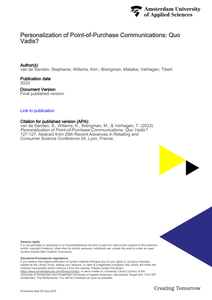In today’s multichannel retail environment, consumers’ experiences in one channel influence their perceptions of another channel. Specifically, consumer evaluations of a firm’s online store have been found to be influenced by consumer interactions with the firm’s in-store personnel. This paper is among the first to address this assumption and test it empirically. Drawing upon the analogical transfer paradigm, we propose hypotheses and accordingly model in-store personnel’s competence and friendliness as determinants of online store usefulness, online store enjoyment, and online store value. Using consumer data collected from two Dutch multichannel retailers, we test this model with partial least squares modeling. The results provide clear support for the model and confirm that consumers may use characteristics of in-store personnel as analogies when evaluating a firm’s online store. Implications for research and retail managers are discussed.
DOCUMENT
In an era of information overload, relevance is key. Even more so in thephysical store, where consumers are in a ‘shopping state of mind’ (Shankaret al., 2010), and where still a significant proportion of all purchasedecisions is being made.Relevance can be achieved by filtering information and targeting shopperswith context-aware messages (Riegger at al. 2022). A commonly studiedexample is that of location-based messaging (i.e. aligning the message withthe consumers’ geographic position; Meents et al. 2020). An alternativeapproach is to adapt the message to the characteristics and behavior of thein-store receiver in question, implying personalization of communication.Various technological devices can be used by retailers to transferpersonalized messages to shoppers in their stores. The focus of this studyis on digital signage (DS) in stores, as these are commonly used byretailers for their digital in-store communication.While the personalization of DS messages may benefit customers (e.g.message relevance), it also comes with high perceived risk to individualprivacy (Hess et al. 2020) To employ these type of personalized messageseffectively, it is important to understand how customers feel and respond.The present study has four objectives, examining (1) whether theperceived benefits of varying levels of personalized DS communication atthe point-of-sale outweigh the perceived risks, (2) why or why not, and (3)who is more and less open to it, and (4) for which specific situations is itmore accepted. We address these objectives both from a practitioner andconsumer perspective, using a mixed-methods approach.First, we have conducted 16 exploratory expert interviews with variousspecialists in the domain of artificial intelligence, shopper marketing, datamanagement and consumer privacy. Transcripts have been contentanalyzedusing NVIVO 12 software. Insights emerged in terms of how toimplement personalized targeting via DS in retail stores, minding legal aswell as ethical challenges in preserving consumer privacy. For example,the level of personalization via in-store digital screens differs greatly; DScontent can be adapted based on customers’ demographics, emotions,preferences and shopping behavior, and all possible combinations of suchpersonal information. It is expected that customers will responddifferently, depending on the level of personalization.In Spring 2023, these results will be complemented based on a consumersurvey. That way, consumers and a multitude of specialists in the smartservices context of personalized communication at the point-of-sale havebeen investigated, allowing for setting the boundaries in terms ofdesirability and feasibility (technology- and privacy preservation-wise).
MULTIFILE
